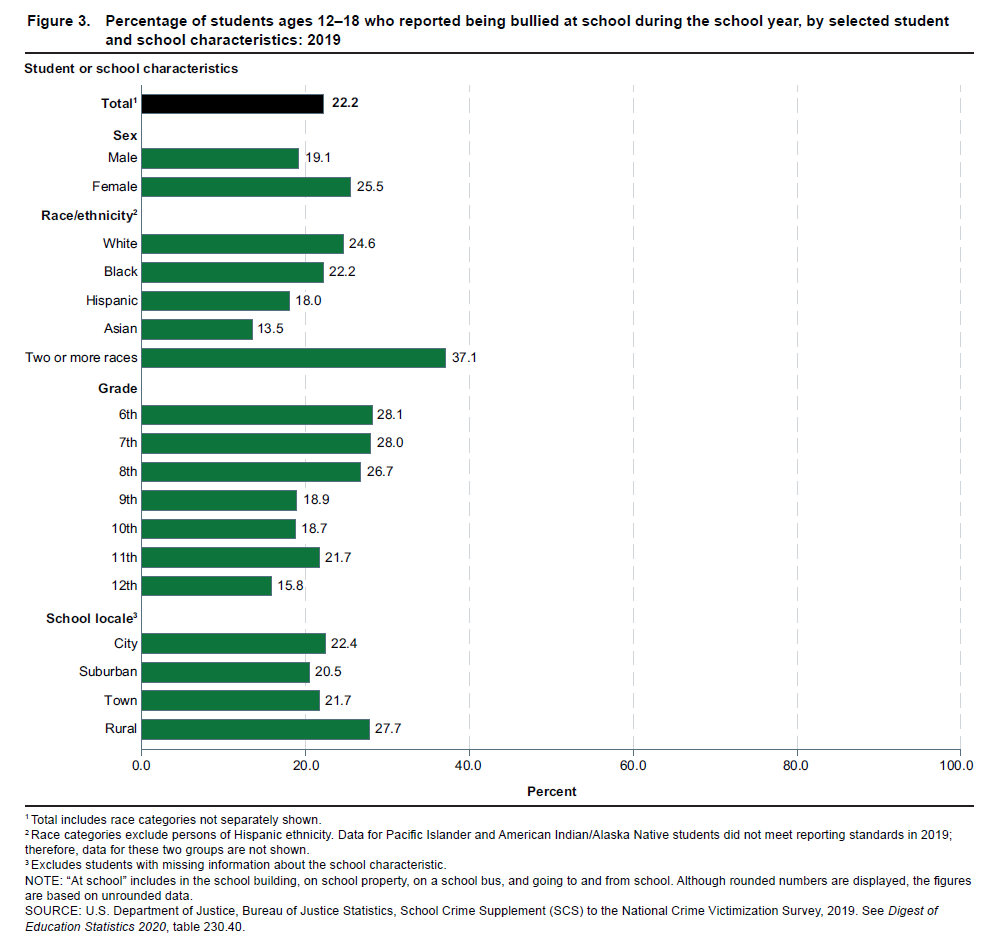High-profile tragedies often shape public opinion on school safety. However, for educators, law enforcement personnel and others working to keep our schools safe, mental health resources and issues such as crime and bullying are also important components of school safety planning.
School Safety Statistics
According to the Report on Indicators of School Crime and Safety: 2021, criminal victimization of students ages 12-18 – including theft, rape, sexual assault, robbery, aggravated assault and simple assault – has declined since 2009. (Victimization rates dropped from 51 per 1,000 students in 2009 to 30 per 1,000 students in 2019.)
Changes to school procedures related to the pandemic coincided with a further 60% decrease from 2019 to 2020 in the student victimization rate – down to 11 per 1,000 students in 2020.
In terms of bullying, the report states that during the 2019-20 school year, about 22% of students ages 12-18 reported being bullied in school. A higher percentage of female students (26%) reported being bullied than male students (19%).
In 2019, about 16% of students in grades 9-12 reported being bullied electronically through texts or social media.
Keeping Students Safe at School
Tip lines have become a common option for gathering information on threats to student or school safety. Preliminary findings from several National Institute of Justice (NIJ)-funded studies on how schools identify, report and respond to threats show tip lines can be a useful violence-prevention tool when coupled with investments in technology, training and a systematic approach to responding to tips.
Threat assessment teams are a promising prevention strategy to assess and respond to threats of violence by students, including mass shootings. These behavioral threat assessment teams may include school administrators, educators, law enforcement and others.
Launched in 2020, SchoolSafety.gov offers actionable recommendations to create a safe and supportive learning environment where students can thrive and grow. The site covers critical areas of interest for school staff and district personnel, including mental health, emergency planning, bullying and cybersecurity.
School Safety Training
School personnel, including school-based law enforcement, receive training to help them prevent, prepare for and respond to violence and student behavioral issues. Studies suggest that training school personnel to prevent and respond to a variety of situations impacting school safety can be effective; however, more research is needed on the efficacy of this practice for school personnel.
Supported by the Bureau of Justice Assistance (BJA), the National Center for School Safety at the University of Michigan provides expert-led training, technical assistance and a database of additional resources to address school safety challenges.
OJP Resources to Improve School Safety
To help school leaders make decisions when implementing new programs, the Office of Juvenile Justice and Delinquency Prevention’s Model Programs Guide provides ratings of programs that focus on aspects of school safety, including bullying, school violence and school climate (the quality of school life). Most of the topics in this guide include school-focused programs.
An NIJ report synthesizes what is known about racial and ethnic equity issues in schools and how equity-informed approaches can be incorporated into a comprehensive school safety strategy. Researchers identified a need for additional studies that evaluate the implementation of equity-focused policies and alternatives to exclusionary and zero-tolerance policies and practices.
Learn more about student safety by reading the educational material available at NSOPW.gov. NSOPW's 'How to Prevent' section offers age-appropriate resources and tips to prevent and respond to sexual assault and abuse. Educational topics include information on evidence-based prevention programs and typical stages of healthy development as well as tips for discussion on sexual abuse with children and teens, resources for educators and more.
School Safety Funding Opportunities
Through the Student, Teachers, and Officers Preventing (STOP) School Violence Program, BJA offers grants to improve security within schools and on school grounds through evidence-based programs.
In FY22, BJA awarded more than $80 million through STOP to support anti-bullying training and specialized training for school officials to respond to mental health crises. Funds also supported the development and implementation of multidisciplinary threat assessment teams and technology solutions such as anonymous reporting systems, including mobile telephone applications, hotlines and websites.
Visit the OJP Current Funding Opportunities page to find all funding opportunities available from OJP that support school safety initiatives.
More on School Safety from OJP
Visit the following pages for additional information and resources produced or sponsored by the Office of Justice Programs and other federal agencies:
| School Safety: Bullying | School Safety: Violence |
| School Safety: Training | School Safety: Additional Resources |



